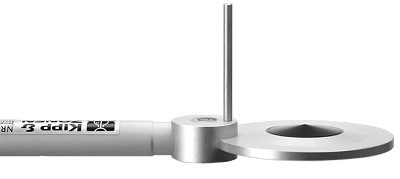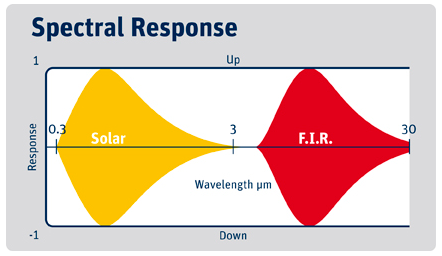NR Lite2 - Net Radiometer
NR Lite2 is designed to measure total radiation, which represents the balance between incoming and outgoing radiation in the outdoor environment.

Difference between CNR4 and NR Lite2 radiometers
Both devices use thermocouples, but the dome above the thermocouple determines what type of radiation passes through and reaches the thermocouple. The thermocouple is usually protected by a single or double dome to reduce deviations caused by sudden temperature changes such as wind.
The CNR4 net radiometer uses two glass domes to cover the pyranometer and two silicon domes to cover the pyrgeometers. It uses two thermoelectric detectors (1 for each of the two pyranometers and 1 for each of the two pyrgeometers) and provides two separate outputs. One for short waves (solar spectrum having a bandwidth of 300 nm to 2800 nm) and one for long wave radiation (long wave infrared spectrum having a bandwidth from 4500 nm to 42000 nm). This leaves a gap between 2800 nm and 4500 nm. This is the so-called atmospheric window, into which very little radiation enters (see picture below).

The NR Lite2 net radiometer is not protected by domes and is in direct contact with weather conditions. Due to the wind, it can therefore cool much more significantly, which affects the accuracy of the measurement. The NR Lite2 does not use a glass or silicon cover but has two PTFE coated detectors and provides a single output for shortwave and longwave radiation. It uses one thermocouple to measure the full spectrum of far infrared and solar radiation. The PTFE thermocouple cover transmits a band from 200 nm up to 100,000 nm.
Note:
As mentioned, the NR Lite2 is wind sensitive. The correction can theoretically be performed by multiplying the calculated radiation by a factor (1 + x • v¾), where v is the wind speed in m/s and x is determined empirically - approximately 0.01.
Connection of signal cable terminals:
red: + voltage signal
black: - voltage signal
shielding
Technical parameters
Spectral range (for 50% decrease): 0.2 to 100 µm
Rise time (for 63% of final value): <20 s
Sensitivity (typical): 10 µV/W/m2
Directional sensitivity (up to 60º): <3%
Sensor asymmetry (upper/lower): <15%
Main menu
- Solutions
- Tap water treatment
- Dispatching accessible via the Internet
- Remote water meter reading
- Monitoring of water leak
- Measurement of qualitative water parameters
- Measurement in Water Supply Network
- Pressures and flows regulation
- Controlling of water pumps and water reservoirs
- Controlling technology of waste purification plants
- Flow processing into charts
- Waste water treatment
- Monitoring of running and technology of WWTP
- Control technology of WWTP
- Measurement of waste water flow
- Dissolved oxygen measurement and aeration blowers control
- Measurement of chemical parameters of water
- Local control of pumping stations
- Remote control of pumping stations
- Root zone waste water treatment plants
- Dispatching accessible via the Internet
- Processing of measured flow data
- Water level monitoring
- Flood warning system
- Environmental monitoring
- Water level and flow monitoring in small water-courses
- Temperature measurement in bore holes and water basins
- Monitoring of soil humidity and temperatures
- Measurement of rain-fall quantity and intensity
- Level measurement in boreholes and remote data collecting
- Measurement of water temperature and conductivity in boreholes
- Measurement of well yield – pumping tests
- Water-level regulation in boreholes
- Capacity and intensity of drainage water
- Thermal balance in ecological constructions
- Meteorological stations
- Relative humidity and air temperature, rainfall, global radiating, atmospheric pressure, speed and direction of wind
- Satellite transfer while the GSM signal is unavailable
- Meteorological stations for agriculture and research institutes
- Extension of meteorological stations about special sensors
- Different type of tower constructions
- Data transfers into the Internet
- Special kinds of graphs for visualization
- Irrigation control systems
- Data collecting and processing
- Data hosting on the server
- Software MOST
- Parameterization of stations via the Internet
- Transferring of measured data into a current dispatcher programme
- Visualization and processing of data
- Data exports from the server into the PC
- Overview reports working-out and printing
- An automatic emails sending
- Types of SIM cards
- Operating costs of the telemetric station
- Industrial applications
- Tap water treatment
- Products
- Monitoring and control units for water supply
- Small telemetric stations and data loggers
- Smart Metering - remote meter readings
- Water level meters
- Hydrostatic level meters
- Radar level meters
- Ultrasonic level meters
- Level gauges for wells, boreholes and reservoirs
- Level float switches
- Equipment for pumping tests of boreholes and wells
- Local Warning Systems
- Flow meters for open channels
- Water quality sensors
- Meteorological stations and measuring sensors
- Accessories for control units and data loggers
- Boxes and cabinets for telemetry and control units
- Gel accumulators, batteries and backup sources
- AC power supplies and battery chargers
- Photovoltaic solar panels
- Antennas and extension cables
- Sensor cables, connectors and connecting expanders
- Communication signal converters and communication cables
- Mechanical mounting elements
- Industrial and residential water meters
- Server software and services
- References
- Support & Download
- About us
- Monitoring
- Datahosting
- OPTIMA Control unit
Documentation
Download
Application
no related solutions


